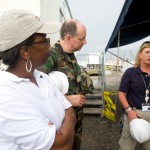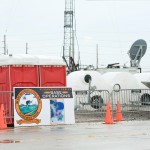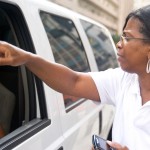You are here
Katrina Responder Applies Lessons Learned to Oil Spill
This story was gathered during David Snyder's visit to New Orleans. David reports on CDC programs in action for the CDC Foundation.
If you watch her eyes as she drives slowly through the Lower 9th Ward, you can almost see the events of Hurricane Katrina unfolding again for Avis Gray. As the regional administrator for the Louisiana Office of Public Health in New Orleans, Gray was at ground zero when the levees surrounding the city broke and cannot forget what she saw in the weeks that followed.



“There was a moment when I was told we would need 20,000 body bags,” Gray says. “It was beyond comprehension. If you stopped and thought about it, it was too much.”
Gray was put to the test yet again after the explosion of the Deepwater Horizon oil rig caused oil to begin spewing into the Gulf in April 2010, catapulting responders like her once again into a major emergency.
“The impact of this oil spill is going to exceed Katrina,” Gray says. “It’s going to affect the cultural livelihood of our fishermen. A way of life, a culture, may be destroyed.”
Like many who served as first responders to Katrina, Gray was affected personally by the disaster. Her own home in New Orleans East was destroyed, yet she spent the first week after the levees broke tirelessly helping to coordinate the evacuation of the Louisiana Superdome and other areas of the city in Katrina’s aftermath. When the levees gave way, Gray used her energy and initiative to organize bus drivers into an impromptu response and recovery team as the water poured in.
“We were our own cavalry,” Gray says. “Given what we had, we did an awesome job.”
The years since Katrina have been reflective ones for many who were involved in the response, both personally and professionally. Much of the city, especially the Lower 9th Ward, remains largely destroyed. For Gray, who still serves as the regional administrator responsible for some of the worst affected areas of the city, Katrina brought with it a long list of lessons learned.
“What has happened for all of us is the understanding that no man is an island,” Gray says. “We now have a regional plan. We used to operate as individual parishes, but we can’t survive like that.”
Now, Gray says that government agencies across the state and between states are working together across sectors to better understand the capabilities and weaknesses of each organization so that they can respond more quickly and efficiently when disaster strikes, as several have since Katrina in 2005.
“You have to think of your continuity of operations plan. H1N1 taught us that,” Gray says. “From a medical standpoint, an acronym might mean one thing to me and to a policeman it might mean something else. We have to learn each other’s language.”
To help make those connections, a Southeast Louisiana Meta-Leadership Summit for Preparedness took place in New Orleans in June 2010, just over a month after the oil spill began. At the Summit, more than 120 leaders like Gray came together to strengthen their teamwork learn how best to coordinate a cross-sector response to large-scale disasters and threats like the oil spill, Katrina, terrorist attacks and pandemic flu.
“Because of my background in high-risk areas I’m a ‘jump in and do it’ kind of person,” Gray says. “I had to learn to bring it down a level and say ‘Let’s make a plan here.’ I have a respect now for what everybody brings to the table.”
Touring the Lower 9th Ward with visitors to her native city, Gray’s love for the people and history of New Orleans is evident. Though she lost much to the flooding, she is acutely aware of how much others lost to Katrina, which killed as many as 1,600 people in the city and damaged or destroyed 80 percent of the homes. Working long days again after the oil spill ravaged the state’s coast, Gray says she is better prepared now for the challenges she will face as the spill and its aftermath drag on.
“That’s what leadership is,” Gray says. “I’ve got to be calm in the face of crazy.”
PROGRAM SNAPSHOT
Purpose:
The Meta-Leadership Summit for Preparedness is a unique national initiative to better prepare business, government and nonprofit leaders to work effectively together during a public health or safety crisis. Through the Summit, leaders learn skills needed for effective action during times of crisis and build organizational connections to strengthen community preparedness for responding to and recovering from emergencies. Learn more at www.meta-leadershipsummit.org.
Funding Partners:
The Summit is supported on the national level by the Robert Wood Johnson Foundation. In lieu of a registration fee for Summit participants, local sponsors cover the Summit’s operational expenses.
Program Partners:
CDC, National Preparedness Leadership Initiative – Harvard School of Public Health
CDC Principal Investigator:
Andrea Young, Ph.D., Office of Public Health Preparedness and Response
CDC Foundation’s Role:
The CDC Foundation is organizing more than 30 Summits in cities across the country to train 3,000 leaders. For each Summit, the CDC Foundation identifies local hosts and sponsors from the business, government and nonprofit sectors and works with them to develop a successful Summit in their community.
